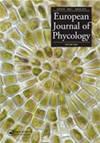Nannochloropsis oceanica (Eustigmatophyceae) mutants resistant to rose bengal demonstrate high tolerance to oxygen
IF 1.7
4区 生物学
Q2 MARINE & FRESHWATER BIOLOGY
引用次数: 0
Abstract
ABSTRACT The genus Nannochloropsis (Eustigmatophyceae), including N. oceanica, has attracted considerable interest, due to its ability to accumulate high levels of lipids. Under large-scale cultivation outdoors, cells are exposed to a combination of high oxygen and light irradiance conditions that may promote photoinhibition, so selecting strains able to tolerate oxidative stress is desirable. Rose bengal (RB) reacts with oxygen to form singlet oxygen in the presence of light. Therefore, RB can be a very useful tool for testing the sensitivity of algae to oxidative stress and thus identify strains capable of photosynthesis under oxidative stress. In this study, two mutants of N. oceanica, RB2 and RB113, which are resistant to high concentrations of rose bengal, were phenotypically characterized for their sensitivity to high oxygen concentrations. Both strains exhibited levels of catalase and ascorbate peroxidase 1.5- and 3-fold higher, respectively, than the wild type. In addition, the synthesis of carotenoids was lower than in the wild type, indicating lower oxidative stress. These results were confirmed by chlorophyll fluorescence measurements, which indicated a lower sensitivity of the photosynthetic apparatus of the mutants, especially of RB2, even in the presence of H2O2. The results support the hypothesis that resistance to rose bengal may also induce resistance to high dissolved oxygen stress. The ability shown by the mutants to perform photosynthesis more efficiently under high oxygen stress than the wild type makes them promising candidates for outdoor cultures.海洋纳米绿藻(Eustigmatophyceae)突变体对孟加拉玫瑰的抗性表现出对氧的高耐受性
摘要:包括海洋猪笼草在内的南绿藻属因其积累高水平脂质的能力而引起了人们的极大兴趣。在户外大规模培养下,细胞暴露在高氧和光照条件下,这可能会促进光抑制,因此选择能够耐受氧化应激的菌株是可取的。玫瑰红(RB)在光的存在下与氧反应形成单线态氧。因此,RB可以是一种非常有用的工具,用于测试藻类对氧化应激的敏感性,从而鉴定能够在氧化应激下进行光合作用的菌株。在本研究中,对耐高浓度孟加拉玫瑰的两个N.oceanica突变体RB2和RB113进行了表型表征,以确定其对高氧浓度的敏感性。这两种菌株的过氧化氢酶和抗坏血酸过氧化物酶水平分别比野生型高1.5倍和3倍。此外,类胡萝卜素的合成低于野生型,表明氧化应激较低。这些结果通过叶绿素荧光测量得到了证实,这表明即使在H2O2存在的情况下,突变体的光合装置,特别是RB2的灵敏度也较低。研究结果支持了对孟加拉玫瑰的抗性也可能诱导对高溶解氧胁迫的抗性的假设。突变体在高氧胁迫下比野生型更有效地进行光合作用的能力使它们成为户外培养的有希望的候选者。
本文章由计算机程序翻译,如有差异,请以英文原文为准。
求助全文
约1分钟内获得全文
求助全文
来源期刊

European Journal of Phycology
生物-海洋与淡水生物学
CiteScore
4.80
自引率
4.20%
发文量
37
审稿时长
>12 weeks
期刊介绍:
The European Journal of Phycology is an important focus for the activities of algal researchers all over the world. The Editors-in-Chief are assisted by an international team of Associate Editors who are experts in the following fields: macroalgal ecology, microalgal ecology, physiology and biochemistry, cell biology, molecular biology, macroalgal and microalgal systematics, applied phycology and biotechnology. The European Journal of Phycology publishes papers on all aspects of algae, including cyanobacteria. Articles may be in the form of primary research papers and reviews of topical subjects.
The journal publishes high quality research and is well cited, with a consistently good Impact Factor.
 求助内容:
求助内容: 应助结果提醒方式:
应助结果提醒方式:


